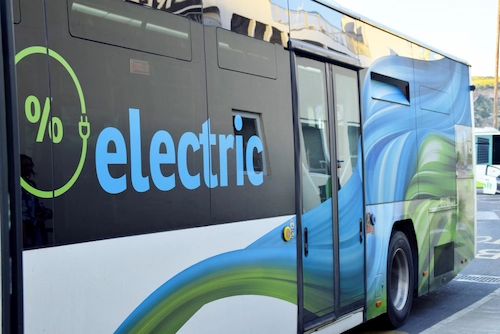Table of Contents
Have you ever imagined if we could travel without feeling guilty about leaving a carbon footprint? That is the concept of sustainable transport. Sustainable transport refers to moving from one place to another in an efficient and eco-friendly way.
Sustainable transport becomes a solution that enables us to move freely while also protecting the Earth. Let’s read this article thoroughly to see how we can implement sustainable transport in our lives.
What Is Sustainable Transport?

Sustainable transport is a mobility system designed to meet people’s needs while protecting the environment, public health, and the well-being of future generations.
This system involves the integration of environmentally friendly technology, efficient public infrastructure, smart urban planning, and changes in community behavior to minimize greenhouse gas emissions and negative socio-economic impacts.
While you may usually focus on the comfort and speed of vehicles, sustainable transport looks further ahead, considering how mobility can continue to run smoothly without making the Earth hotter.
As a result, eco-friendly technology, efficient public transportation, passenger and bikers’ infrastructure, and the government’s regulation must align.
Read also: Causes of Greenhouse Gases and How to Prevent Them!
Why Is Sustainable Transport Important?
Did you know? The transportation sector contributes about 13.7% of the total greenhouse gas emissions globally. Most of them come from fossil-fueled private vehicles, land logistics, and air and sea transportation.
Imagine this: Whenever you drive your fossil-fueled car, you also release a carbon footprint into the atmosphere. If this continues, the goal of keeping global temperatures from rising excessively may be impossible to achieve.
Therefore, it is not surprising that the world is paying greater attention to sustainable transport as one of the major solutions to overcome the climate crisis.
Read also: 8 Public Transport Benefits for the Society & Environment
Sustainable Transport Strategies

You might be wondering, what is the most effective strategy to reduce carbon emissions? Especially if every country or city has different conditions. Here are some common strategies we can implement:
1. Electric Vehicle
Shifting from fossil-fueled to electric vehicles is one of the fastest strategies with the most significant results in reducing transportation emissions. An electric vehicle is not only for private cars but also for buses, trucks, and logistics fleets.
The latest data from Physics and Society (2025) showed that the full electrification of land vehicles, in addition to smart charging and vehicle-to-grid (V2G), is the most economical transition strategy for reducing emissions in Europe.
Smart charging can reduce the stationary battery needs up to 40%, and eventually, it can shorten the large-scale energy system cost.
In other words, an electric vehicle is not merely a technological trend but also a real solution for energy efficiency and sustainability.
2. Modern Public Transportation
Investing in environmentally friendly public transportation is also very important. Comfortable, affordable, and emission-free public transportation can be the most effective solution to reduce dependence on private vehicles.
For example, switching from private vehicles to low-emission modes of public transportation, such as electric buses, renewable energy-based trains, and support for bicycle lanes and pedestrian facilities. For logistics, the approach includes multimodal networks and the electrification of short-distance delivery.
Meanwhile, in the maritime and aviation sectors, the transition is being achieved through the use of sustainable fuels, efficient ship and aircraft design, the use of shore power in ports, and the development of new technologies. All these steps can create a modern public transportation system that is greener, more efficient, and low-carbon.
Read also: 6 Ways to Conserve Energy with a Sustainable Lifestyle
3. Active Mobility

In implementing sustainable transport strategies, do not underestimate simple things like walking and cycling. According to Transportation Research Part D: Transport and Environment (2021), average people shifting from vehicles to cycling could reduce carbon emissions up to 3.2 kg of CO2 per day.
Therefore, you can start with walking at least 30 minutes a day for short-distance travel, syncing for 30 minutes for groceries or working. A two-hour business trip by train is also more cost-effective and environmentally friendly than air travel.
In addition to being environmentally friendly, active mobility also improves health, reduces air pollution, and makes cities healthier. It is no surprise that many cities in Europe have made bicycles the foundation of their transportation systems.
4. Multimodal and Ridersharing
A combination of various transportation modes, from buses and trains to ridesharing and bicycles, can be an efficient mobility solution. Multimodal mobility can make you travel easily without being stuck in a traffic jam.
Moreover, with integrated digital applications for navigation, ticket booking, and payment, this system becomes more practical, and people can stop relying on private vehicles.
5. Government Support and Regulation
It is undeniable that major changes require a clear policy. The government plays a major role in accelerating the transition to sustainable transport.
Emission regulations, incentives for electric vehicles, carbon taxes, and the development of green infrastructure can encourage people to switch to sustainable transport more quickly.
In brief, sustainable transportation is key to reducing emissions, maintaining air quality, and creating healthier cities. Simple choices, such as using public transportation, cycling, or walking, are concrete steps toward reducing emissions while promoting health.
Regarding this sustainable principle, there are many efforts you can make to protect the environment. For example, you can support #AksiAsri from Indonesia Asri.
This program invites you to increase awareness on environmental preservation, such as sorting waste before disposing of it or implementing a sustainable lifestyle.
Moreover, you can also spread information about environmental awareness campaigns and invite your friends to participate. Every small step you take towards a sustainable lifestyle will contribute directly to preserving the Earth.
What are you waiting for? Register yourself to be a part of change with Warga Asri for a greener Earth!
Read also: 8 Benefits of Electric Cars for Drivers & the Environment
FAQ About Sustainable Transport
1. What is sustainable transport?
Sustainable transport refers to transportation systems that are environmentally friendly, energy efficient, and socially inclusive, aiming to reduce pollution and dependence on fossil fuels.
2. Why is sustainable transport important?
It helps lower greenhouse gas emissions, reduces air pollution, saves energy, improves public health, and supports long-term urban sustainability.
3. What are examples of sustainable transport?
Examples include walking, cycling, electric vehicles (EVs), public transit systems, carpooling, and the use of renewable energy-powered transport.
5. How does sustainable transport benefit the environment?
It reduces carbon emissions, decreases noise pollution, conserves natural resources, and supports cleaner and healthier cities.
5. What is the role of public transportation in sustainability?
Public transport reduces traffic congestion, lowers individual carbon footprints, and makes mobility more affordable and efficient for large populations.
Explore More Environmental Care Action Videos:










